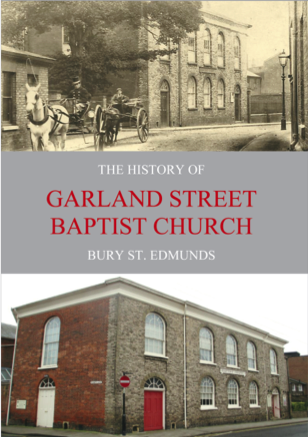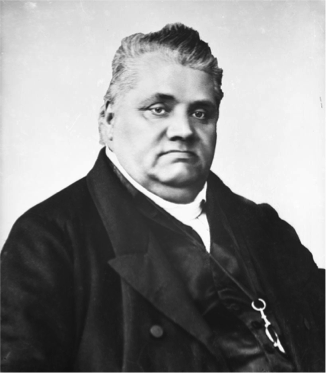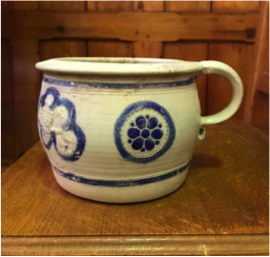'A rich history of ministry, and many unique events'
Garland Street Baptist Church in Bury St. Edmunds celebrated its 220th anniversary in July. To commemorate the occasion, a new book presents the church’s role in the town, across East Anglia, and beyond through more than two centuries. Key local events are interwoven in the narrative of The History of Garland Street Baptist Church to provide context for what was happening in the church. Author and church member Terry Tyrell introduces it
 The story begins in the mid-1600s as various nonconformist groups first appeared across Suffolk. In those days, men and women devoted to Baptist principles joined other groups for worship, although their individual doctrines didn’t always coincide. It would be a century and a half before Baptists in Bury established their own church—Ebenezer Chapel.
The story begins in the mid-1600s as various nonconformist groups first appeared across Suffolk. In those days, men and women devoted to Baptist principles joined other groups for worship, although their individual doctrines didn’t always coincide. It would be a century and a half before Baptists in Bury established their own church—Ebenezer Chapel.
The Revd Thomas Ridley baptised the original 10 members on the day the chapel opened in July 1800. Interestingly, within seven years, five of them had been dismissed for offences ranging from financial misconduct to attending public places of amusement and other vanities. During that period, several townsfolk joined Ebenezer, but others were removed for conducting ‘worldly business’ on the Lord’s day, breaking the Sabbath, or ‘singing vain songs and drinking amongst vain company with much levity.’
Under the leadership of a succession of four pastors over its first 23 years, membership rose to 49. In addition to ministry in the town, Ebenezer established 22 ‘preaching stations’ in villages around Suffolk. The slow growth of the church began to change dramatically when Cornelius Elven, a 26-year-old native of Bury who worked as a leather-cutter, became pastor in May 1823.
 The Revd Elven led the church for 50 years, and membership increased to nearly 650. The chapel was enlarged in 1828, but within six years, the building was no longer sufficient for the rapidly growing congregation. Garland Street Baptist Church opened in May 1834. Within two decades, the combined attendance at three Sunday worship services topped 2,000 people.
The Revd Elven led the church for 50 years, and membership increased to nearly 650. The chapel was enlarged in 1828, but within six years, the building was no longer sufficient for the rapidly growing congregation. Garland Street Baptist Church opened in May 1834. Within two decades, the combined attendance at three Sunday worship services topped 2,000 people.
Between 1824 and 1852, Garland Street established another 47 ‘preaching stations’ in villages across the county. Cornelius travelled extensively to preach, and from time to time, his trips were quite eventful. On one occasion, he and his horse and carriage were run off the road by an intoxicated man in a cart. On another trip, he was harassed by ‘a company of lewd fellows of the baser sort’ who kept yelling and howling as he led worship. He was also a mentor to Charles Haddon Spurgeon when the teenager started his career as a Baptist minister in Waterbeach near Cambridge.
Garland Street has a rich history of ministry similar to all Baptist churches across the country, but what stands out in more than two centuries of church records are the unique events that have taken place through the years.
In 1876, as church members made plans to host a bazaar to raise funds for a building project, the local milkman donated a goat for the event’s raffle. When Garland Street was looking for a new pastor in 1903, the church received two letters from a minister in Twickenham in the span of a week. The first accepted and the second declined the open position. This was fortunate as the church hadn’t called him to the post.
Eight years later, members voted not to sing ‘amen’ at the end of any hymn. During World War I, Garland Street offered its facilities to the Red Cross during emergencies and insured the church for £7,000 against Zeppelin damage. In the 1940s, the hall was opened to soldiers serving in the town, and the pastor volunteered with the Royal Observer Corps.
 At a church meeting in 1957, it was noted that a large toilet jug and basin had vanished. The mystery was partially solved more than five decades later when workmen uncovered an antique chamber pot while digging a trench next to the church.
At a church meeting in 1957, it was noted that a large toilet jug and basin had vanished. The mystery was partially solved more than five decades later when workmen uncovered an antique chamber pot while digging a trench next to the church.
Garland Street has long served men and women in need across the town. In 1973, the church hall was opened four days each week for the elderly, but alcohol and gambling were strictly forbidden! After a lapse of a few years, a second club for the elderly was started in 1980. The building also was used as a drop-in centre for the homeless, initially in 1997 and later in 2003 and 2015.
In 1986, as part of a national Boys’ Brigade event, three church families visited 10 Downing Street at the invitation of the Prime Minister. Margaret Thatcher personally hosted the group for a tour of her official residence and served tea, juice, and biscuits to her guests.
As are all other churches across the country, Garland Street is currently learning to minister in new ways during the Coronavirus pandemic. Prior to the lockdown, the church experienced a number of challenges, especially with respect to attracting, serving, and retaining young people and families. Membership declined and longstanding programmes shut down because of lack of participants or volunteers.
Only God knows what lies ahead for the church, but members pray continually that the God who multiplied a group of 49 Christians in 1823 to 647 in less than five decades will be at work just as miraculously in 2020 and beyond.
The History of Garland Street Baptist Church is on sale for £10 (plus postage). To order a copy, contact author Terry Tyrell by email at history@garlandstreet.org.uk
Baptist Times, 02/09/2020